高中英语阅读之推理判断题的解题技巧
高中英语四种阅读理解的解题技巧

高中英语四种阅读理解的解题技巧高中英语四种阅读理解的解题技巧今天给大家分享高中英语四种阅读理解的解题技巧,快跟店铺一起看看吧!一、细节题型【提问方式】Wh-特殊问句; From the text…,According to…,True/not true,划线词语、句子,简单计算、排列事件顺序、识图等。
【解题方法】抓住提问中的关键字眼,仔细阅读相关细节的材料内容,一般可以在短文中直接找到或稍加归纳就可以找到正确答案。
注意排除下列干扰项:(1)扩缩范围文章为了表达得准确严密,很注意对范围的限定。
有的是通过加上相应的词语限制,如涉及到数量时常用many,almost all,nearly,more than,over,only a few,normally等限制。
有些干扰项是通过改变或去掉限定词语,甚至是扩大或缩小了语言范围。
(2)偷换概念命题者设计试题时往往把原文的概念偷换成另一个不同的`概念。
望文生义是造成错误的主要原因。
(3)正误并存在一干扰项中,某个句子或词语是正确的,其他分句或词语是错误的或表达不全面,正误并存,命题者借此以假乱真。
要排除这类干扰项,只要一个选项局部有误或选项不全面,都属排除的干扰项。
二、主旨大意题型【提问方式】What' s the topic/subject of the text/the second paragraph?What is stated in…? The text is cheifly concerned with_______。
【解题方法】(1)最常用的方法是仔细研读短文的1、2两句-----即短文的主题句,或辅以阅读各段的第1、2句----即段落中心句。
此方法多适用于说明文、议论文。
(2)记叙文等需要通读全文,抓住关键事或论题来归纳意思(常说明一个道理)。
(3)全文末尾(段)找答案。
此类文章的特点是以列举事实开头,通过论证,最后阐述核心观点。
在处理文章标题的选择时,要避免下列三种错误:①概括不够(多表现为部分代整体,从而导致范围太小);②过度概括(多表现为人为扩大范围);③以事实或细节代替抽象具体的大意。
高中英语:阅读理解之推理判断专项讲解
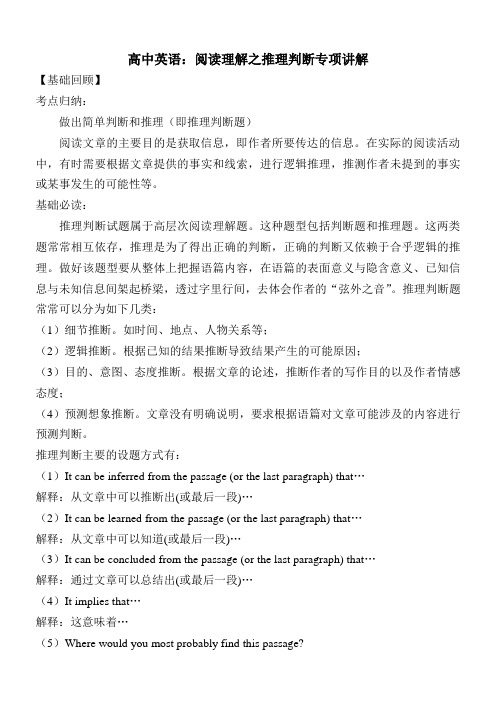
高中英语:阅读理解之推理判断专项讲解【基础回顾】考点归纳:做出简单判断和推理(即推理判断题)阅读文章的主要目的是获取信息,即作者所要传达的信息。
在实际的阅读活动中,有时需要根据文章提供的事实和线索,进行逻辑推理,推测作者未提到的事实或某事发生的可能性等。
基础必读:推理判断试题属于高层次阅读理解题。
这种题型包括判断题和推理题。
这两类题常常相互依存,推理是为了得出正确的判断,正确的判断又依赖于合乎逻辑的推理。
做好该题型要从整体上把握语篇内容,在语篇的表面意义与隐含意义、已知信息与未知信息间架起桥梁,透过字里行间,去体会作者的“弦外之音”。
推理判断题常常可以分为如下几类:(1)细节推断。
如时间、地点、人物关系等;(2)逻辑推断。
根据已知的结果推断导致结果产生的可能原因;(3)目的、意图、态度推断。
根据文章的论述,推断作者的写作目的以及作者情感态度;(4)预测想象推断。
文章没有明确说明,要求根据语篇对文章可能涉及的内容进行预测判断。
推理判断主要的设题方式有:(1)It can be inferred from the passage (or the last paragraph) that…解释:从文章中可以推断出(或最后一段)…(2)It can be learned from the passage (or the last paragraph) that…解释:从文章中可以知道(或最后一段)…(3)It can be concluded from the passage (or the last paragraph) that…解释:通过文章可以总结出(或最后一段)…(4)It implies that…解释:这意味着…(5)Where would you most probably find this passage?解释:你最有可能在哪里找到这篇文章?(6)What would the author most likely continue to talk about in the next paragraph(s)?解释:作者很可能会在下一段(或下文中)继续谈论什么?【技能方法】推理判断主要的解题策略有:(1)根据不同文体,推断目的意图。
高中英语阅读理解之推断题(思维导图+练习含答案)
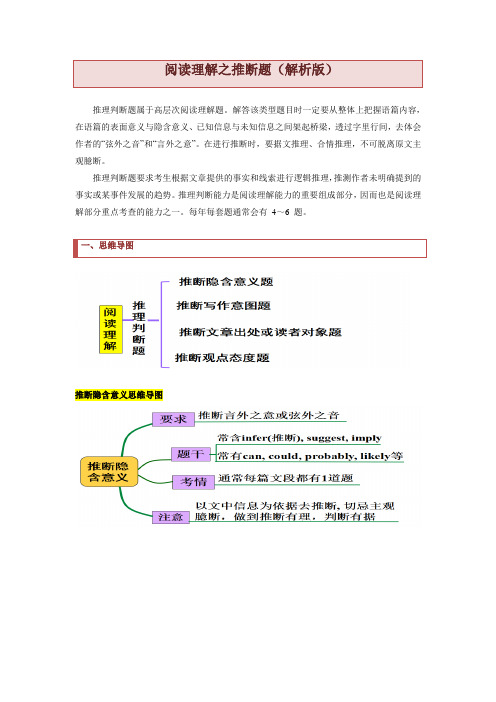
阅读理解之推断题(解析版)推理判断题属于高层次阅读理解题。
解答该类型题目时一定要从整体上把握语篇内容,在语篇的表面意义与隐含意义、已知信息与未知信息之间架起桥梁,透过字里行间,去体会作者的“弦外之音”和“言外之意”。
在进行推断时,要据文推理、合情推理,不可脱离原文主观臆断。
推理判断题要求考生根据文章提供的事实和线索进行逻辑推理,推测作者未明确提到的事实或某事件发展的趋势。
推理判断能力是阅读理解能力的重要组成部分,因而也是阅读理解部分重点考查的能力之一。
每年每套题通常会有4~6 题。
一、思维导图推断隐含意义思维导图二、方法点拨(一)推理判断题题干常用词一般来说,推理判断题题干中主要包括下面的词语:know about, learn from, infer, imply, suggest, conclude, purpose, attitude, probably, most likely等。
(二)推理判断题正确选项特征推理判断题中的正确选项是依据文章的事实或证据推断出的符合逻辑的结论或观点,正确选项一般具有以下特征:1.“立足原文,只推一步”,即根据原文内容,一步即可推得。
2.选项中一般不可以出现绝对概念。
如only, never, all, absolutely等,正确答案的表述一般有一点模糊,会用一些相对能够留有一些余地的词汇,如often, usually, sometimes, some, may, might, can, could, possibly, probably等。
(三)推理判断题干扰选项特征1.曲解文意:即推测意义与文章表层意义有区别。
推理判断题中有些选项来自文章中的某一句或某几句话,命题者可能会利用里面的词设计出干扰项,看似表达文章的意思,其实是借题发挥,是对原文意思的曲解。
2.张冠李戴:即把文章中作者的观点与其他人的观点混淆在一起。
题干问的是作者的观点,选项中出现的却是其他人的观点;题干问的是其他人的观点,选项中却出现了作者的观点。
完整版)高中英语阅读之推理判断题的解题技巧

完整版)高中英语阅读之推理判断题的解题技巧推理判断题是高层次阅读理解题中较为主观的一种,考生需要根据作者所陈述的细节、事实以及措辞、态度和语气,找出表露作者思想倾向和感情色彩的词句,然后运用相关知识进行推理判断,得出符合逻辑的结论。
近年来,高考中经常出现以下五种推理判断题:一、推断隐含意义或深层意义1.这类题干中通常含有learn(),infer(),suggest(),imply(),conclude()。
indicate()等标志性词语,常见的提问方式有:1).We can know from the passage that ________.2)。
We can infer from the (first/last) passage that ________.3).___ ______.4).It ___ ________.5).The underlined sentence indicates that ________2.解题技巧①针对细节推断:在原文中找到相关的信息源,对具体内容进行分析,推理判断得出结论。
例如,原文中提到“你是否曾经听到过从墙壁里传来的奇怪声音?它听起来像是一个时钟吗?如果是的话,那可能是由一个甲虫制造的。
很久以前,人们认为这个滴答声意味着有人即将死去。
因此,这种甲虫被称为“死亡守望者甲虫”。
从文中可以推断出,这种甲虫的声音让人感到________。
A.高兴B.惊讶C.恐惧D.兴奋需要填的是C,因为文中明确提到人们曾经认为这种声音意味着有人即将死去,因此可以推断出这种声音让人感到恐惧。
Why ___ any good news。
All I read about is murder。
bribery。
and death。
Frankly。
I’m sick of all the bad news.The author ___。
___ with the constant barrage of bad news。
高中英语阅读中推理判断题的题型分析与解题技巧
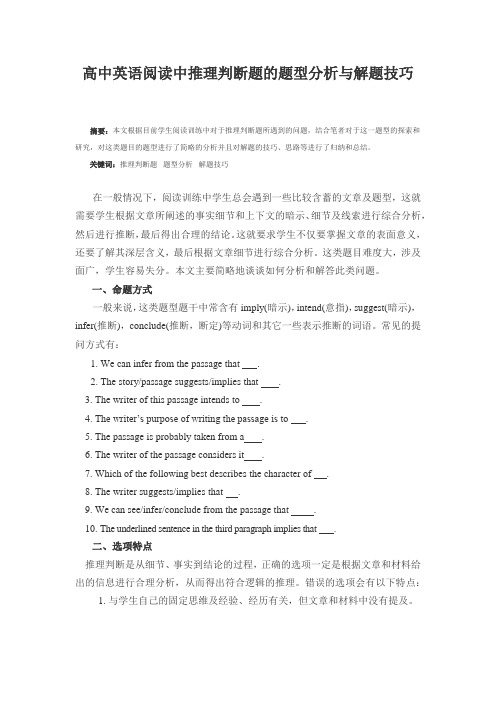
高中英语阅读中推理判断题的题型分析与解题技巧摘要:本文根据目前学生阅读训练中对于推理判断题所遇到的问题,结合笔者对于这一题型的探索和研究,对这类题目的题型进行了简略的分析并且对解题的技巧、思路等进行了归纳和总结。
关键词:推理判断题题型分析解题技巧在一般情况下,阅读训练中学生总会遇到一些比较含蓄的文章及题型,这就需要学生根据文章所阐述的事实细节和上下文的暗示、细节及线索进行综合分析,然后进行推断,最后得出合理的结论。
这就要求学生不仅要掌握文章的表面意义,还要了解其深层含义,最后根据文章细节进行综合分析。
这类题目难度大,涉及面广,学生容易失分。
本文主要简略地谈谈如何分析和解答此类问题。
一、命题方式一般来说,这类题型题干中常含有imply(暗示),intend(意指),suggest(暗示),infer(推断),conclude(推断,断定)等动词和其它一些表示推断的词语。
常见的提问方式有:1. We can infer from the passage that .2. The story/passage suggests/implies that .3. The writer of this passage intends to .4. The writer’s purpose of writing the passage is to .5. The passage is probably taken from a .6. The writer of the passage considers it .7. Which of the following best describes the character of .8. The writer suggests/implies that .9. We can see/infer/conclude from the passage that .10. The underlined sentence in the third paragraph implies that .二、选项特点推理判断是从细节、事实到结论的过程,正确的选项一定是根据文章和材料给出的信息进行合理分析,从而得出符合逻辑的推理。
英语阅读理解技巧之推理判断题的研究

阅读理解技巧之推理判断题的研究一、选题理由从教几年来,我上过很多公开课,也观摩过很多公开课,公开课的课型多是阅读课,因为阅读课容易操作,学生熟悉,他们会积极参与课堂,使人看起来师生配合默契,课堂气氛活跃,教学效果良好。
现在我所执教的年级是高三,备课组分给我的公开课任务是阅读理解,如果现在再拿一篇课文上阅读课,意义不是很大,一是课文都学过了,再上就没有新鲜感;其次,高三都是复习课而且时间很紧,再上阅读课有点浪费时间。
那上什么更实用呢?上周日学校组织高三青年教师去合肥学习,我也在学习之列。
上午参加一个讲座,讲课人是来自合肥一中的刘李老师,她讲课的内容是针对高三一轮复习,对每个考试题型介绍了她与她同事的一些做法。
讲到阅读理解时,她说我们要指导学生判断每一个问题的类型,是细节题还是推理判断题,是猜测词义题还是主旨大意题,并且针对每一个问题类型给出相应的解题方法。
在教学中我也讲解阅读理解,却很少这样做,我也只告诉他们怎么找到问题的答案,却没有系统的方法指导。
回来的路上,我问同行的八位英语老师,在教学中,关于阅读理解你们像刘李老师这样做过吗?他们都一致摇头说没有。
顿时,我觉得要做点什么来改变我的阅读理解的教学现状。
学习回来再提到公开课时,我就想为什么不上一节实用的阅读理解解题方法指导课呢?一节课时间有限,不能面面俱到,只能针对某一问题类型进行解题指导。
对学生来说,在阅读理解的各个题目类型中,他们觉得很难同时失分率很高的就是推理判断题,他们需要相应的方法指导。
那这节公开课的主题就有了:阅读理解解题技巧之——推理判断题。
上这样的方法指导课也是一种挑战:一是没有现成的方法可循;二是教学内容和解题方法需要自己总结;三是纯粹的理论方法课,课堂气氛可能会很沉闷。
但是如果这节课上好了,不仅给同事提供一种可供参考的教学模式,而且还可以让学生掌握这种题型的解题方法。
二、学情分析我们利辛高级中学是一所安徽省示范高中,但是学生的学习素养和成绩却不及同是安徽示范高中的利辛一中。
高中英语高中英语必考点解题指导:考点妙解13 推理判断教案
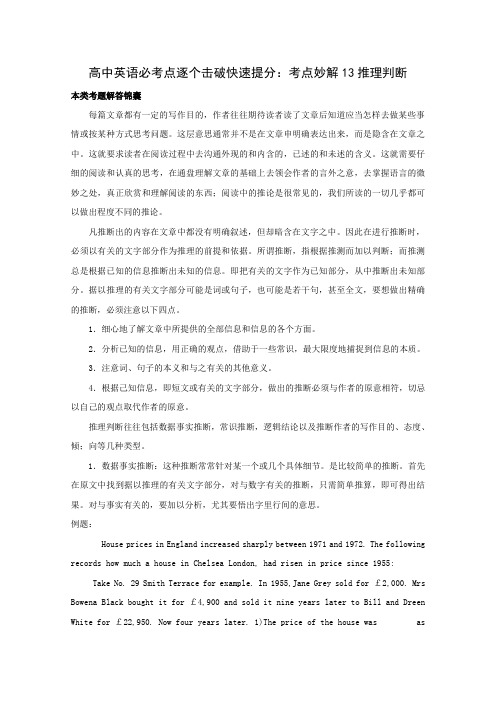
高中英语必考点逐个击破快速提分:考点妙解13推理判断本类考题解答锦囊每篇文章都有一定的写作目的,作者往往期待读者读了文章后知道应当怎样去做某些事情或按某种方式思考问题。
这层意思通常并不是在文章申明确表达出来,而是隐含在文章之中。
这就要求读者在阅读过程中去沟通外现的和内含的,已述的和未述的含义。
这就需要仔细的阅读和认真的思考,在通盘理解文章的基础上去领会作者的言外之意,去掌握语言的微妙之处,真正欣赏和理解阅读的东西;阅读中的推论是很常见的,我们所读的一切几乎都可以做出程度不同的推论。
凡推断出的内容在文章中都没有明确叙述,但却暗含在文字之中。
因此在进行推断时,必须以有关的文字部分作为推理的前提和依据。
所谓推断,指根据推测而加以判断;而推测总是根据已知的信息推断出未知的信息。
即把有关的文字作为已知部分,从中推断出未知部分。
据以推理的有关文字部分可能是词或句子,也可能是若干句,甚至全文,要想做出精确的推断,必须注意以下四点。
1.细心地了解文章中所提供的全部信息和信息的各个方面。
2.分析已知的信息,用正确的观点,借助于一些常识,最大限度地捕捉到信息的本质。
3.注意词、句子的本义和与之有关的其他意义。
4.根据己知信息,即短文或有关的文字部分,做出的推断必须与作者的原意相符,切忌以自己的观点取代作者的原意。
推理判断往往包括数据事实推断,常识推断,逻辑结论以及推断作者的写作目的、态度、倾;向等几种类型。
1.数据事实推断:这种推断常常针对某一个或几个具体细节。
是比较简单的推断。
首先在原文中找到据以推理的有关文字部分,对与数字有关的推断,只需简单推算,即可得出结果。
对与事实有关的,要加以分析,尤其要悟出字里行间的意思。
例题:House prices in England increased sharply between 1971 and 1972. The following records how much a house in Chelsea London, had risen in price since 1955:Take No. 29 Smith Terrace for example. In 1955,Jane Grey sold for £2,000. Mrs Bowena Black bought it for £4,900 and sold it nine years later to Bill and Dreen White for £22,950. Now four years later. 1)The price of the house was ashigh in 1972 as in the yearJane Grey sold it.A. about ten timesB. twiceC. 150 percentD. fifteen times2)Mrs Bowena Black made a prof it (利润)of______.A. £2,900B. £8,典型例题£7,典型例题 D. £18,典型例题Of all the tenants,who earned most?A. The Whites.B. Jane Grey.C. Mrs Black.D. Mr White.4)When did Mrs Black buy the house?A. 1971.B. 1972C. 1968.D. 19595)Jane Grey lived at No. 29 Smith TerraceA. for four yearsB. for nine yearsC. between 1971 and 1972D. before 19556)If MrS B1aCk had waited four years to setl the house She would have earned as much as_______.A.£28,000 B.£18,000 C.£30,000 D.£25,100以上各题的推理前提均可在原文中找到。
如何解决高中英语推理判断题
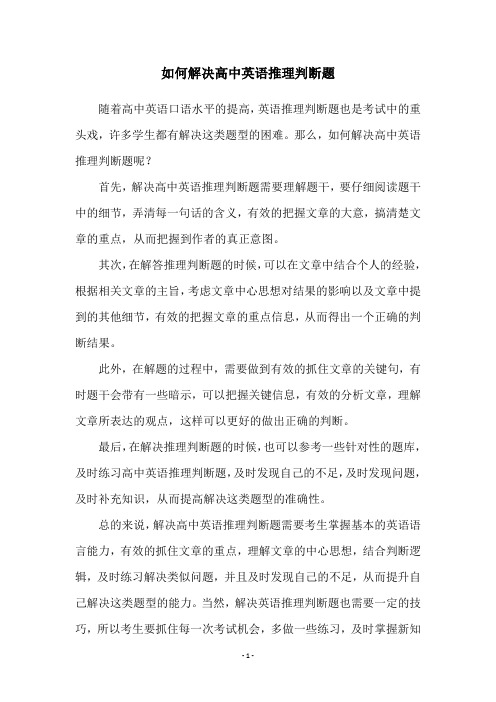
如何解决高中英语推理判断题
随着高中英语口语水平的提高,英语推理判断题也是考试中的重头戏,许多学生都有解决这类题型的困难。
那么,如何解决高中英语推理判断题呢?
首先,解决高中英语推理判断题需要理解题干,要仔细阅读题干中的细节,弄清每一句话的含义,有效的把握文章的大意,搞清楚文章的重点,从而把握到作者的真正意图。
其次,在解答推理判断题的时候,可以在文章中结合个人的经验,根据相关文章的主旨,考虑文章中心思想对结果的影响以及文章中提到的其他细节,有效的把握文章的重点信息,从而得出一个正确的判断结果。
此外,在解题的过程中,需要做到有效的抓住文章的关键句,有时题干会带有一些暗示,可以把握关键信息,有效的分析文章,理解文章所表达的观点,这样可以更好的做出正确的判断。
最后,在解决推理判断题的时候,也可以参考一些针对性的题库,及时练习高中英语推理判断题,及时发现自己的不足,及时发现问题,及时补充知识,从而提高解决这类题型的准确性。
总的来说,解决高中英语推理判断题需要考生掌握基本的英语语言能力,有效的抓住文章的重点,理解文章的中心思想,结合判断逻辑,及时练习解决类似问题,并且及时发现自己的不足,从而提升自己解决这类题型的能力。
当然,解决英语推理判断题也需要一定的技巧,所以考生要抓住每一次考试机会,多做一些练习,及时掌握新知
识,多多练习,这样可以提升自己的英语推理判断题解决能力。
高考英语阅读理解解题技巧之细节理解题和推理判断题导学案
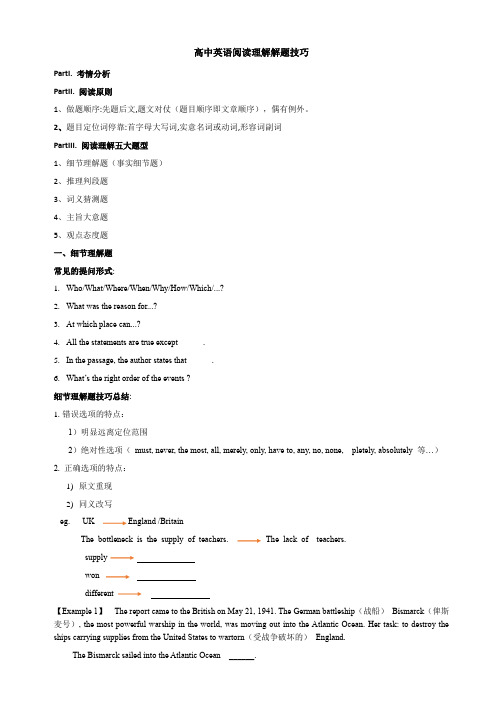
高中英语阅读理解解题技巧PartI. 考情分析PartII. 阅读原则1、做题顺序:先题后文,题文对仗(题目顺序即文章顺序),偶有例外。
2、题目定位词停靠:首字母大写词,实意名词或动词,形容词副词PartIII. 阅读理解五大题型1、细节理解题(事实细节题)2、推理判段题3、词义猜测题4、主旨大意题5、观点态度题一、细节理解题常见的提问形式:1.Who/What/Where/When/Why/How/Which/...?2.What was the reason for...?3.At which place can...?4.All the statements are true except.5.In the passage, the author states that.6.What’s the right order of the events ?细节理解题技巧总结:1.错误选项的特点:1)明显远离定位范围2)绝对性选项(must, never, the most, all, merely, only, have to, any, no, none, pletely, absolutely 等…)2. 正确选项的特点:1)原文重现2)同义改写eg. UK England /BritainThe bottleneck is the supply of teachers. The lack of teachers.supplywondifferent【Example 1】The report came to the British on May 21, 1941. The German battleship(战船)Bismarck(俾斯麦号), the most powerful warship in the world, was moving out into the Atlantic Ocean. Her task: to destroy the ships carrying supplies from the United States to wartorn(受战争破坏的)England.The Bismarck sailed into the Atlantic Ocean ______.A. to sink the Hood(胡德号战舰)B. to gain control of FranceC. to cut off American supplies to BritainD. to stop British warships reaching Germany【Example 2】The report came to the British on May 21, 1941. The German battleship(战船)Bismarck(俾斯麦号), the most powerful warship in the world, was moving out into the Atlantic Ocean. Her task: to destroy the ships carrying supplies from the United States to wartorn(受战争破坏的)England.The British had feared such a task. No warships(战船)they had could match the Bismark(俾斯麦号)in speed or in firepower(火力). The Bismarck had eight 15inch guns(火炮)and 81 smaller guns. She could move at 30 nautical miles (海里) an hour. She was believed to be unsinkable(不沉的).Many people believed that the Bismarck was the most strongest one because she ______.A. was fast and powerfulB. had more men on boardC. was under Luetjens’ mandD. had bigger guns than other ships牛刀小试:【EX. 1】However, the British had to sink her. They force their best battleship Hood(胡德号战舰)to hunt down the Bismarck(俾斯麦号). On May 24, the Hood found the Bismarck.It was a meeting(会面)that the German mander(指挥官)did not want to see. His orders were to destroy the British ships that were carrying supplies, but to stay away from a fight with British warships.The battle didn’t last long. The Bismarck’s first torpedo (鱼雷) hit the Hood, which went down taking all but three of her 1, 419 men with her.We learn from the text that on 24 May ______.A. the British won the battle against the BismarckB. the Bismarck won the battle against the BritishC. the British gunfire damaged the Bismarck seriouslyD. the Bismarck succeeded in keeping away from the British【EX. 2】But in the fight, the Bismarck was slightly damaged . Her mander decided to run for repairs to France, which had at that time been taken by the Germans. The British force followed her. However, because of the Bismarck’s speed and the heavy fog, they lost sight of her.Her mander tried to sail(航行)to France in order to ______.A. have the ship repairedB. join the other GermansC. get help from the FrenchD. get away from the British二、推理判断题常见提问方式1.The passage implies (暗示) that_______.2.We can conclude (得出结论) from the passage that_____.3.Which of the following can be inferred (推论)?4.What is the tone (语气) of the author ?5.What is the purpose (目的) of this passage?6.The passage is intended to (倾向于) _____.7.Where would this passage most probably appear(出现)?8.The next paragraph would most probably deal with_______.9.At the end of this passage, the writer might continue to write _______.技巧点拨:1.推断隐含意义【Example 1】A buildityourself solar still(自制太阳能蒸馏器)is one of the best ways to obtain drinking water in areas where the liquid is not readily available…..The only ponents(成分)required, though, are a 5' ×5' sheet of clear(透明的)or slightly milky(略带乳白色的)plastic, six feet of plastic tube(试管), and a container(容器)—perhaps just a drinking cup —to catch the water. These pieces can be folded(折叠)into a neat little pack and fastened(系)on your belt(腰带).1.What do we know about the solar still (蒸馏器)from the first paragraph? ()A. It’s delicate(精致的).B. It’s expensive.C. It’s plex.D. It’s portable(便携的).推断隐含意义题技巧总结:①Scanning,找到相关信息点②Study reading,不但理解表层,而且要由表及里、由浅入深地分析③推理,以文中提供的信息为依据,结合常识,作出符合逻辑的推断2.推断写作目的【Example 1】It’s an amazing acplishment(成就)and one we cannot achieve without generous support from individuals, corporations(企业), and other social organizations(组织). Visit to find various ways you can support Pacific Science Center.1.What is the purpose of the last part of the text? ()A. To encourage supports.B. To advertise ing events.C. To introduce special exhibits.D. To tell about the Center’s history.推断写作目的题技巧总结1:找句来推断写作目的。
高中英语阅读理解技巧之推理判断
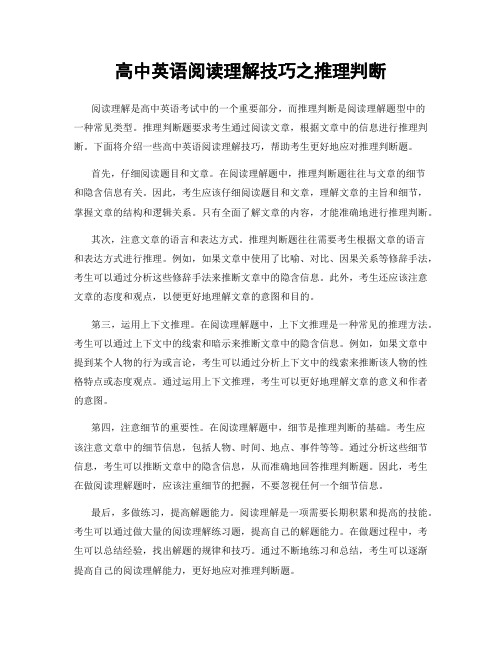
高中英语阅读理解技巧之推理判断阅读理解是高中英语考试中的一个重要部分,而推理判断是阅读理解题型中的一种常见类型。
推理判断题要求考生通过阅读文章,根据文章中的信息进行推理判断。
下面将介绍一些高中英语阅读理解技巧,帮助考生更好地应对推理判断题。
首先,仔细阅读题目和文章。
在阅读理解题中,推理判断题往往与文章的细节和隐含信息有关。
因此,考生应该仔细阅读题目和文章,理解文章的主旨和细节,掌握文章的结构和逻辑关系。
只有全面了解文章的内容,才能准确地进行推理判断。
其次,注意文章的语言和表达方式。
推理判断题往往需要考生根据文章的语言和表达方式进行推理。
例如,如果文章中使用了比喻、对比、因果关系等修辞手法,考生可以通过分析这些修辞手法来推断文章中的隐含信息。
此外,考生还应该注意文章的态度和观点,以便更好地理解文章的意图和目的。
第三,运用上下文推理。
在阅读理解题中,上下文推理是一种常见的推理方法。
考生可以通过上下文中的线索和暗示来推断文章中的隐含信息。
例如,如果文章中提到某个人物的行为或言论,考生可以通过分析上下文中的线索来推断该人物的性格特点或态度观点。
通过运用上下文推理,考生可以更好地理解文章的意义和作者的意图。
第四,注意细节的重要性。
在阅读理解题中,细节是推理判断的基础。
考生应该注意文章中的细节信息,包括人物、时间、地点、事件等等。
通过分析这些细节信息,考生可以推断文章中的隐含信息,从而准确地回答推理判断题。
因此,考生在做阅读理解题时,应该注重细节的把握,不要忽视任何一个细节信息。
最后,多做练习,提高解题能力。
阅读理解是一项需要长期积累和提高的技能。
考生可以通过做大量的阅读理解练习题,提高自己的解题能力。
在做题过程中,考生可以总结经验,找出解题的规律和技巧。
通过不断地练习和总结,考生可以逐渐提高自己的阅读理解能力,更好地应对推理判断题。
总之,推理判断是高中英语阅读理解题中的一种常见类型。
通过运用上述的阅读理解技巧,考生可以更好地应对推理判断题,提高自己的解题能力。
高中英语推理判断题解题技巧
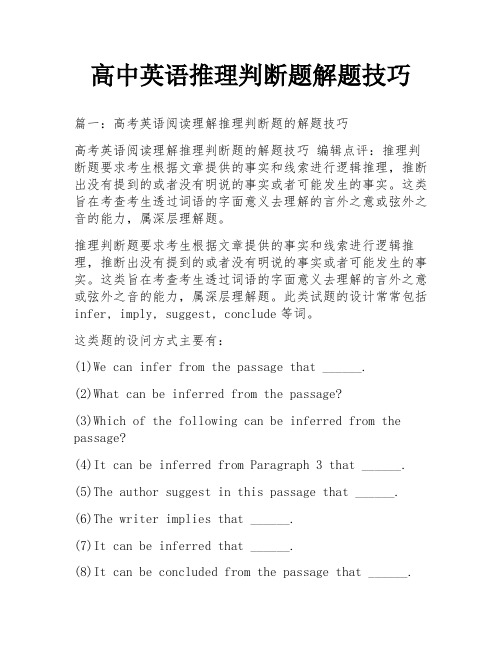
高中英语推理判断题解题技巧篇一:高考英语阅读理解推理判断题的解题技巧高考英语阅读理解推理判断题的解题技巧编辑点评:推理判断题要求考生根据文章提供的事实和线索进行逻辑推理,推断出没有提到的或者没有明说的事实或者可能发生的事实。
这类旨在考查考生透过词语的字面意义去理解的言外之意或弦外之音的能力,属深层理解题。
推理判断题要求考生根据文章提供的事实和线索进行逻辑推理,推断出没有提到的或者没有明说的事实或者可能发生的事实。
这类旨在考查考生透过词语的字面意义去理解的言外之意或弦外之音的能力,属深层理解题。
此类试题的设计常常包括infer, imply, suggest, conclude等词。
这类题的设问方式主要有:(1)We can infer from the passage that ______.(2)What can be inferred from the passage?(3)Which of the following can be inferred from the passage?(4)It can be inferred from Paragraph 3 that ______.(5)The author suggest in this passage that ______.(6)The writer implies that ______.(7)It can be inferred that ______.(8)It can be concluded from the passage that ______.(9)On the whole, we can conclude that ______.(10)From the text we can conclude that ______.(11)After reading the passage we may conclude that______.(12)What conclusion can be drawn from the passage?(13)The author is inclined to think that ______.(14)When the writer talks about..., what he really means is that______.(15)What's the writer's attitude towards...?(16)What's the author's feeling towards...?(17)In the writer's opinion...理解文段的隐含信息包括:推测或人物的观点、态度、意图、身份、情感,对或文段所涉及的人物、事件作出评价等,属于深层理解,是语言学习者必须具备的交际能力之一。
英语阅读理解解题技巧高中

英语阅读理解解题技巧高中想要了解高中英语阅读理解有什么解题技巧的小伙伴,赶紧来瞧瞧吧!下面由小编为你精心准备了“英语阅读理解解题技巧高中”,本文仅供参考,持续关注本站将可以持续获取更多的资讯!英语阅读理解解题技巧高中1、细节题解题技巧细节题的命题方法很多,如可能是对某个细节用同义结构转换后进行考查、也可能是将文章中的几个细节(通常是四个)放在一起要求考生判断是非(选出正确的一项或选出错误的一项)或对几个细节进行排序等。
解答这类试题时,一个常用的方法就是运用定位法,即根据题干或选项中的线索词从原文中找到相关的句子,与选项进行比较从而确定答案(此时要特别注意一些常见的同义转换)。
(1)、关键信息定位法。
这个主要是细节题,如涉及到数字(日期、时间、价格等),就可以在文章中快速圈出数字,再找出目标数字及相对应的细节作息,还有人物姓名、地点名词等等,其他的还包括一些提示情节发展,或条纲性关键字眼,如First,Next,Finally等等。
(2)、同义定位法。
英文中可以用Paraphrase表示。
同义定位就是指问题所用的关键词和文中的不一致,但属于同义性质,同义转换其实是在关键间的基础上拐个弯。
2、推理题解题技巧推断题定义:在理解原文字面意思的基础上,通过对语篇逻辑关系的分析和细节的暗示,做出一定的判断和推理,从而得到文章的深层意义及隐含意义的过程。
出现特征:在考题中经常出现的词有infer,imply,indicate,conclude,learn from,probably,most likely,prove/according to等。
3、主旨大意题解题技巧(1)、要在阅读原文基础上,仔细考虑选项是否与文章主题有密切联系;(2)、再看选项对文章的概括性或覆盖面如何;(3)、要注意题目是否过大或者过小;(4)、要避免下列三种错误:概括不够(多表现为部分代整体,导致范围过小)、过度概括(多表现为扩大范围)、以事实、细节代替抽象概括的大意。
(完整版)高中英语阅读之推理判断题的解题技巧
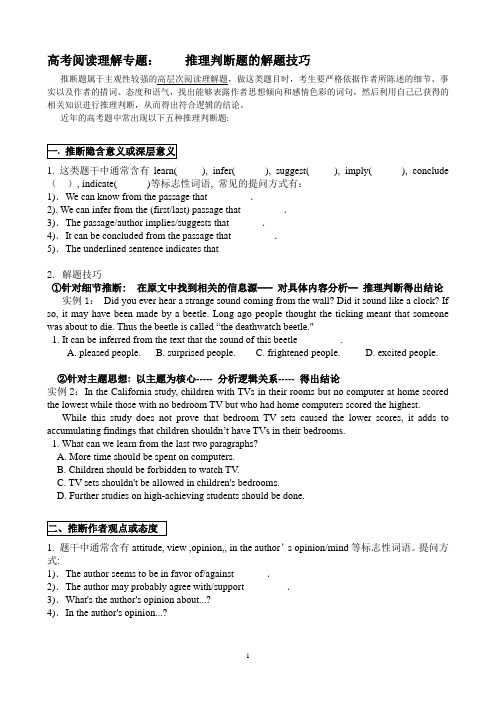
高考阅读理解专题:推理判断题的解题技巧推断题属于主观性较强的高层次阅读理解题,做这类题目时,考生要严格依据作者所陈述的细节、事实以及作者的措词、态度和语气,找出能够表露作者思想倾向和感情色彩的词句,然后利用自己已获得的相关知识进行推理判断,从而得出符合逻辑的结论。
近年的高考题中常出现以下五种推理判断题:1. 这类题干中通常含有learn( ), infer( ), suggest( ), imply( ), conclude (), indicate( )等标志性词语, 常见的提问方式有:1).We can know from the passage that ________.2). We can infer from the (first/last) passage that ________.3).The passage/author implies/suggests that ______.4).It can be concluded from the passage that ________.5).The underlined sentence indicates that ________2. 解题技巧①针对细节推断: 在原文中找到相关的信息源--- 对具体内容分析-- 推理判断得出结论实例1:Did you ever hear a strange sound coming from the wall? Did it sound like a clock? If so, it may have been made by a beetle. Long ago people thought the ticking meant that someone was about to die. Thus the beetle is called “the deathwatch beetle."1. It can be inferred from the text that the sound of this beetle ________.A. pleased people.B. surprised people.C. frightened people.D. excited people.②针对主题思想:以主题为核心----- 分析逻辑关系----- 得出结论实例2:In the California study, children with TVs in their rooms but no computer at home scored the lowest while those with no bedroom TV but who had home computers scored the highest.While this study does not prove that bedroom TV sets caused the lower scores, it adds to accumulating findings that children shouldn’t have TVs in their bedrooms.1. What can we learn from the last two paragraphs?A. More time should be spent on computers.B. Children should be forbidden to watch TV.C. TV sets shouldn't be allowed in children's bedrooms.D. Further studies on high-achieving students should be done.1. 题干中通常含有attitude, view ,opinion,, in the author’s opinion/mind等标志性词语。
高考英语推理判断题解题策略

高考英语推理判断题解题策略在每年的高考英语的试卷中,推理判断题都占着很大的比例,在选择题、阅读理解题等题型当中,很大部分都涉及到了推理判断题,很多学生都对推理判断题感到困惑,但是推理判断题属于主观题型,是层次较高的题目,直接影响到到考生英语整体的成绩。
本文就高考英语推理判断题解题策略进行简要的分析。
一、高考英语推理题判断题的命题形式根据推理判断题的性质以及2014年高考的出题范围,我们大致可以将高考英语推理判断题解题的题型分为局部推理、全文推理以及判断题三个部分。
局部推理题,指的是对于文章细节内容的判断能力以及考查能力,局部推理题对应的内容有时候是文章的一句话或几句话,有时候也可以是一两个段落,与其他的题型相比,由于这类型的题目经常在题干中包含“The author believes that…,The author implies that”等类似的推理用词,因此对于高中生来讲应该是相对比较容易快速定位的推理题。
全文推理题这种题型,一般不是单单的考查对于高中生对于全文中心思想的推理,同样也考查对细节的推理。
全文推理题由于它的这些细节散布在文章的各个角落,因此需要考生对文章进行全面的归纳。
判断题这种题型是细节题以及推理题的综合,它的形式分为正向判断和反向判断两种方式,其要求是考生应该根据所给的信息,找到符合原文信息的选项,而且四个选项所涉及的内容可能分布在文章各个段落,因此,对学生提出了更高的要求,即需要考生迅速定位并进行推理判断。
判断题的一般问法包括“Which of the following is true?”以及“Which of the following is not true”等判断问法。
二、高考英语推理题判断题选的项特点分析根据对英语高考推理题型长期的分析,我么往往会得到以下的结论,即是命题人在设置选项的时候,往往会遵循一定的特点和规律,因此,高中生在平时的练习过程中,应该不断琢磨分析推理判断题选项的相应特点。
高中高考英语阅读理解推理判断题解题技巧.docx
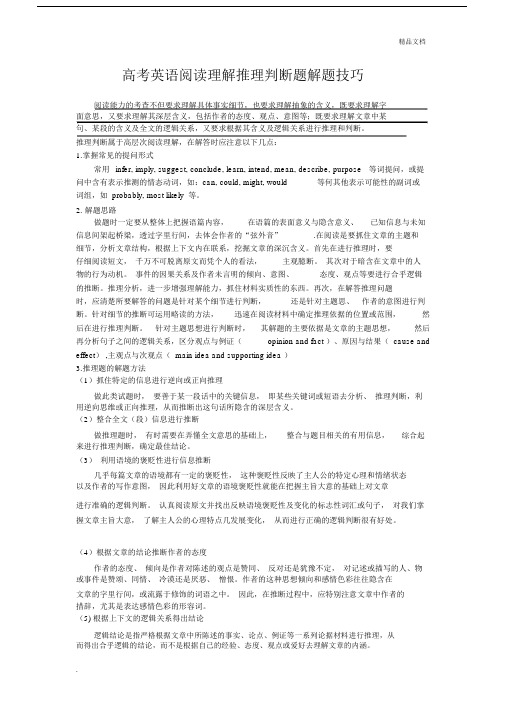
高考英语阅读理解推理判断题解题技巧阅读能力的考查不但要求理解具体事实细节,也要求理解抽象的含义,既要求理解字面意思,又要求理解其深层含义,包括作者的态度、观点、意图等;既要求理解文章中某句、某段的含义及全文的逻辑关系,又要求根据其含义及逻辑关系进行推理和判断。
推理判断属于高层次阅读理解,在解答时应注意以下几点:1.掌握常见的提问形式常用infer, imply, suggest, conclude, learn, intend, mean, describe, purpose等词提问,或提问中含有表示推测的情态动词,如:can, could, might, would等何其他表示可能性的副词或词组,如 probably, most likely 等。
2. 解题思路做题时一定要从整体上把握语篇内容,在语篇的表面意义与隐含意义、已知信息与未知信息间架起桥梁,透过字里行间,去体会作者的“弦外音”.在阅读是要抓住文章的主题和细节,分析文章结构,根据上下文内在联系,挖掘文章的深沉含义。
首先在进行推理时,要仔细阅读短文,千万不可脱离原文而凭个人的看法,主观臆断。
其次对于暗含在文章中的人物的行为动机。
事件的因果关系及作者未言明的倾向、意图、态度、观点等要进行合乎逻辑的推断。
推理分析,进一步增强理解能力,抓住材料实质性的东西。
再次,在解答推理问题时,应清楚所要解答的问题是针对某个细节进行判断,还是针对主题思、作者的意图进行判断。
针对细节的推断可运用略读的方法,迅速在阅读材料中确定推理依据的位置或范围,然后在进行推理判断。
针对主题思想进行判断时,其解题的主要依据是文章的主题思想,然后再分析句子之间的逻辑关系,区分观点与例证(opinion and fact )、原因与结果( cause and effect) ,主观点与次观点( main idea and supporting idea )3.推理题的解题方法(1)抓住特定的信息进行逆向或正向推理做此类试题时,要善于某一段话中的关键信息,即某些关键词或短语去分析、推理判断,利用逆向思维或正向推理,从而推断出这句话所隐含的深层含义。
全攻略-高中英语阅读理解题型体裁解读、解题技巧及练习(附答案)

高考英语阅读理解技巧点拨—推理判断题(一)题型复习阅读理解归纳为以下四大题型,根据阅读理解题考查角度的不同,可采用不同的解题技巧来应付。
Ⅰ.事实细节题Ⅱ.猜测词义题学会”顺藤摸瓜",通过构词,语法,定义,同位,对比,因果,常识,上下文等线索确定词义。
在阅读解题时要注意从以下七个方面着手:1)根据定义或解释、说明猜测生词的词义2)根据对比关系猜测生词的词义3)通过因果关系猜测词义4)根据生活常识猜测词义5)根据同等关系猜测词义6)根据列举的事例猜测词义7)根据构词法知识猜测词义Ⅲ.推理判断题做这类题要求考生在阅读理解整体语篇的同时,又要求学生对作者的态度、意图及文章细节的发展作正确的推理判断,力求从作者的角度去考虑,不要固守自己的看法或观点。
不要主观臆断,凭空想象,任意发挥,而走入误区。
学生要学会运用主题句去推测、揣摩文字背后作者的意图,运用归纳、对比、演绎技能,运用背景知识去挖掘文章深层含义,从而正确理解作者的言外之意,同时认真体会文章的语气与感情基调(如:否定、厌恶、反问、讽刺等).这类试题常以如下句式发问:①What can you conclude/ imply from this passage?②What’s the author's attitude(态度)towards.。
?③We can infer /learn from the passage that...Ⅳ.主旨大意题这种题型要求考生能够把握文章的总体,并真正理解主题和中心;要求能较好地运用概括、判断、归纳、推理等逻辑思维方法解题,难度较大,属于高层次题.一般主旨大意题可以分为两类:1.确定文章的标题和主题(title or topic)标题位于文章之首,用来高度概括文章内容,点明文章主题。
它可以是单词,短语,也可以是句子。
要确定文章标题,首先,要在阅读原文的基础上,考虑标题是否与主题密切相关;其次,看标题是否能概括全文内容。
高中英语阅读理解推理判断题解题技巧

高中英语阅读理解推理判断题解题技巧一、找细节,明确范围。
在阅读题目时,首先要仔细阅读题目中的文字,找出关键词,明确题目所涉及的范围。
特别是对于推理判断题,题目的细节非常重要。
通常这类题目会问:What can we infer from the passage? 或者What’s the author’s attitude towards…? 这时就需要我们通过阅读全文,理解作者的意图和态度,从而做出正确的推理判断。
二、析选项,对比原文。
在读完题目后,我们需要仔细分析每个选项,找出选项中的关键词和信息,然后与原文进行对比。
在对比过程中,要注意选项与原文的表述是否一致,以及原文中所涉及的范围是否与选项相符。
如果选项与原文表述不一致,那么这个选项就是错误的。
三、排除法,提高效率。
在分析选项时,我们可以使用排除法来提高解题效率。
首先排除与原文不符的选项,剩下的选项再进行对比分析,最终确定正确答案。
排除法可以帮助我们缩小范围,提高解题效率。
四、读上下文,判断逻辑。
在阅读文章时,要认真分析上下文之间的逻辑关系。
通过读上下文,可以推断出文章中的逻辑关系和作者的意图。
例如,如果文章中前面提到了一种现象,后面又提到了这个现象的原因,那么就可以推断出它们之间存在因果关系。
五、抓关键词,理解文意。
在阅读文章时,要注意抓住文章中的关键词和重点句子,这些关键词和重点句子通常能够反映出文章的主旨和作者的意图。
例如,如果文章中出现了“however”、“but”、“yet”等转折词,那么这些词后面的内容往往就是作者的真实意图。
六、看标点符号,推断语气。
标点符号是文章中不可或缺的一部分,它们不仅可以帮助我们理解文章的语义,还可以帮助我们推断出作者的语气和态度。
例如,问号表示疑问或反问,引号表示引用或强调,破折号表示解释或说明等。
通过分析标点符号,我们可以更好地理解文章的深层含义和作者的意图。
七、关注作者态度,确定文章基调。
在阅读文章时,要特别关注作者的态度和立场。
高中英语阅读理解解题技巧及题型

高中英语阅读理解解题技巧及题型一、句子理解题1.返回原文找到原句。
2.对原句进行语法和词义的精确分析(找主干),应该重点抓原句的字面含义。
若该句的字面含义不能确定,则依据上下文进行判断。
注意:局部含义是由整体决定的。
3.一般来说,选项中的正确答案与原句意思完全相同,只不过用其他英语词汇换种表达而已。
4.句子理解题的错误选项干扰项特征:推得过远。
做题时应把握住推的度。
思路:对句子微观分析?不行就依据上下文?选择时不要推得过远。
二、推理题“最近原则”1.标志:learn,infer,imply,inform2.看是否可以通过题干返回原文或依据选项返回原文。
一般要围绕文中的一两个重点进行推理。
推理题无论通过题干能不能定位,我们都要把它固化到文章的一两点上。
3.依据原文的意思进行三错一对的判断。
先不要进行推理,若有一个选项跟原文的意思一模一样,则该选项必然是正确答案。
提醒:推理题不是考察我们的想象力,它实际是考察我们原文中的某几个点如一个、两个点所涉及的问题我们读透了没有。
因此,不推的比推的好;推的近的比推的远的要好。
4.推理题的最近答案原则:不推的要比推的好,推的近的要比推的远的好,直接推出的要比间接推的好。
(原文的某句话变个说法)注意:做题时不能想得太多,推得过远。
是否把原文读懂才是关键。
三、主旨题“串线摘帽”:即在自然段少的时候串串线,串线法解不出来时,大帽子、小帽子摘一下。
1.主旨题的标志:mainly about,mainly discuss,the best title2.串线法:抓首段和其余各段的第一句话,把其意思连接成一个整体。
要注意总结性的提示词和转折词,特别要注意中心句。
(主要针对自然段少的文章;针对自然段多的文章,主旨题最好联系中心句。
找一个和中心句最贴近的)3.小心首段陷阱。
4.主旨题错误选项的干扰特征经常是:①局部信息,即选项的内容小于文章的内容;②范围过宽,即选项的内容大于文章的内容。
高中英语知识点归纳阅读理解推理与解释的技巧

高中英语知识点归纳阅读理解推理与解释的技巧高中英语知识点归纳:阅读理解推理与解释的技巧阅读理解推理与解释是高中英语学习中的重要内容之一,也是考试中常出现的题型。
掌握相关技巧对提高阅读理解能力和解题效率非常有帮助。
本文将归纳总结高中英语阅读理解推理与解释的技巧,希望对广大学生有所帮助。
一、推理题技巧推理题是在理解文章的基础上,根据已有信息进行逻辑推理得出结论的题型。
以下是解决推理题的一些常用技巧:1.理清文章逻辑关系:在阅读文章时,要注意抓住关键信息,例如因果关系、转折关系、对比关系等。
理清逻辑关系有助于更好地理解文章内容,从而进行正确的推理。
2.运用上下文推测:当遇到生词或不熟悉的表达时,可以通过上下文的线索进行推测。
上下文中的其他信息可能会提供答案的线索,帮助理解词汇或短语的含义。
3.辨别信息的重要性:在阅读理解中,有些信息是重要的,而有些信息只是陈述事实的细节。
要学会辨别哪些信息是关键的,以便在解答推理题时能够有针对性地选择相关信息进行推理。
4.引申推理:通过举一反三的方式,将文章中的某个情节与自己的知识和经验联系起来,进行推理。
这种方法需要学生具备一定的思维拓展能力和背景知识,能够将已知信息与推测进行合理的连接。
二、解释题技巧解释题是基于已有信息对特定问题进行解释或提供相关信息的题型。
以下是解决解释题的一些常用技巧:1.寻找答案线索:在解释题中,答案通常存在于文中具体的细节中。
要仔细阅读题目和相关段落,找到与问题直接相关的信息,可以通过划线、笔记等方式标记出来,以便更好地定位答案。
2.注意作者意图:解释题往往考察学生对作者意图的理解。
要仔细阅读文章,分析作者写作的目的和态度,从而准确解答问题。
可以通过观察词语的积极或消极色彩、使用的修辞手法等来判断作者的意图。
3.理解上下文关系:有时解释题需要学生通过整篇文章的内容进行推断和理解。
要注意把握段落之间的关系,理清文章的逻辑结构,从而更好地理解作者的意图和解答问题。
- 1、下载文档前请自行甄别文档内容的完整性,平台不提供额外的编辑、内容补充、找答案等附加服务。
- 2、"仅部分预览"的文档,不可在线预览部分如存在完整性等问题,可反馈申请退款(可完整预览的文档不适用该条件!)。
- 3、如文档侵犯您的权益,请联系客服反馈,我们会尽快为您处理(人工客服工作时间:9:00-18:30)。
高中英语阅读之推理判断题的解题技巧高考阅读理解专题:推理判断题的解题技巧推断题属于主观性较强的高层次阅读理解题,做这类题目时,考生要严格依据作者所陈述的细节、事实以及作者的措词、态度和语气,找出能够表露作者思想倾向和感情色彩的词句,然后利用自己已获得的相关知识进行推理判断,从而得出符合逻辑的结论。
近年的高考题中常出现以下五种推理判断题:一. 推断隐含意义或深层意义1. 这类题干中通常含有learn( ), infer( ), suggest( ), imply( ), conclude (), indicate( )等标志性词语, 常见的提问方式有:1).We can know from the passage that ________.2). We can infer from the (first/last) passage that ________.3).The passage/author implies/suggests that ______.4).It can be concluded from the passage that ________.5).The underlined sentence indicates that ________2. 解题技巧①针对细节推断: 在原文中找到相关的信息源--- 对具体内容分析-- 推理判断得出结论实例1:Did you ever hear a strange sound coming from the wall? Did it sound like a clock? If so, it may have been made by a beetle. Long ago people thought the ticking meant that someone was about to die. Thus the beetle is called “the deathwatch beetle."1. It can be inferred from the text that the sound of this beetle ________.A. pleased people.B. surprised people.C. frightened people.D. excited people.②针对主题思想:以主题为核心----- 分析逻辑关系----- 得出结论实例2:In the California study, children with TVs in their rooms but no computer at home scored the lowest while those with no bedroom TV but who had home computers scored the highest.While this study does not prove that bedroom TV sets caused the lower scores, it adds to accumulating findings that children shouldn’t have TVs in their bedrooms.1. What can we learn from the last two paragraphs?A. More time should be spent on computers.B. Children should be forbidden to watch TV.C. TV sets shouldn't be allowed in children's bedrooms.D. Further studies on high-achieving students should be done.二、推断作者观点或态度1. 题干中通常含有attitude, view ,opinion,, in the author’s opinion/mind等标志性词语。
提问方式:1).The author seems to be in favor of/against ______.2).The author may probably agree with/support ________.3).What's the author's opinion about...?4).In the author's opinion...?2. 解题技巧注意作者表达感情色彩的形容词、副词、动词及所举的例子,推断出作者的弦外之音。
如overestimate (高估), luckily, unexpectedly, pity, certain等。
表达作者态度和观点的形容词常有:objective(),subjective(),neutral ();positive ()negative()approval (),disapproval (),ironic()indifferent(),critical(),cautious()optimistic(),pessimistic()等。
3. 实例3:Why isn’t your newspaper reporting any good news?All I read about is murder, bribery(行贿),and death. Frankly,I’m sick of all the bad news.1. This author’s attitude towards the new spaper reporting is to _____.A. complainB. apologizeC. amuseD. inform三. 推断文段作用或作者写作意图1. 提问方式:1).The author's main purpose in writing the passage is to ________.2).The passage is meant to ________.3).The author's purpose is to show ________.4).The purpose of the article is to ________.2. 解题技巧①不同的文段在全文中可能会起到:引言/介绍(introduction),举例(example),对比(comparison),反衬(contrast), 结论(conclusion),评论(comment),背景(background),论证(demonstration)等作用。
②作者的写作目的通常有娱乐读者、说服读者接受某种观点和告知读者某些信息三种。
解答此类题时主要有两种方法:1.主旨推断法:写作目的是阐述作者为何要表达某个中心主题,因此可根据主旨推断作者的写作目的。
2.文体推断法:根据文体的特点和用途来推断作者的写作目的。
如记叙文,特别是个人的有趣经历或幽默故事类的文章,其目的是娱乐读者;夹叙夹议的文章,其目的是让读者得到某种启示或教育;广告和议论文的目的是说服读者接受某种产品、服务或接受某种观点;科普说明文或新闻报告,其目的是告知读者某些信息。
3. 实例4 :“Have you ever been out on a boat and felt it lifted up by a wave? Or have you jumped in the water and felt the rush of energy as waves came over you?” asked Jamie Taylor of the Wave Energy Group at the University of Edinburgh. “There is certainly a lot of energy in waves,” he said.1. The writer uses the two questions at the beginning of the passage to ______.A. test the readers’ knowledge about wavesB. draw the readers’ attention to the topicC. show Jamie Taylor’s importanceD. invite the readers to answer them四.推断文章出处和来源1. 提问方式1).The text is most likely to be taken from ________.2).Where does the text probably come from?3).Where can we most probably read this text?2). 解题技巧这类问题应从文章的内容或结构来判断其出处:①报纸:前面会出现日期、地点或通讯社名称。
②广告:因其格式特殊,容易辨认。
③产品说明:器皿、设备的使用说明会有产品名称或操作方式,而药品的服用说明会告知服用时间、次数、药量等。
④网站:文中会出现click(点击),online(在线), web(网络), website(网址)等字眼。
3. 实例5:Don’t wander aimlessly through life. Get focused on your goals, start helping others in need, and live life to the fullest! Life is too short to be anything but happy. Visit my blog and find what you’ve been missing. Sigh up for my newsletter and get seven free e-books, too! Read hundreds of articles while you’re there in the article section, which is updated daily.1. This text must be taken from ___________A. a radio programB. a websiteC. a newspaperD. a TV program五. 推断目标读者推断目标读者,即要求考生根据短文内容和文中的措辞推断此篇文章主要是写给谁看的。
